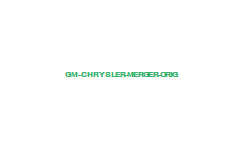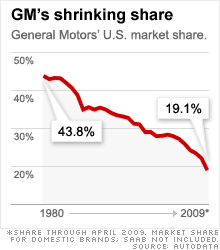Size Matters? No, Says Forbes’ Adam Hartung (At least not for GM to implode)
(Source: Forbes)
GM. Those two letters call up a lot of emotion these days. People ask, “What went wrong?” “How could a company that large, that successful, go bankrupt?” The less polite say: “General Motors’ leadership is corrupt.” “They ignored customers.” “The union killed them.” “Government interference.” “Idiots.”
We used to expect size to benefit a company. Being large and established meant you were supposed to have market clout, and you could protect your profits. According to Michael Porter, Harvard Business School professor and author, being biggest meant you had created entry barriers that kept your turf safe. With economies of scale in manufacturing, procurement, distribution, marketing, sales, financing and research and development, you could get so giant no competitor could effectively attack your products or prices. And for many, many years, nobody was bigger than General Motors ( GMGMQ.PK– news – people ).
The myth of the invulnerability of the large company is dead. We all know that by now. But other than depressing us, what does it mean? What have we learned from these failures that can help us be more successful in the future?
Many theories of business–from the work of Fredrick Winslow Taylor, who introduced modern management practices a century ago, to that of writers like Jim Collins today–have posited that success comes largely from figuring out what business you want to be in and then focusing on it intently. Pay attention to the resources on which you rely, invest to gain advantages of scale, operate with a tight focus on your goals and you should succeed.
This approach is based on an industrial-age understanding of oligopoly, where over time a pool of competitors shrinks to just the most efficient handful that can all be profitable in the long term. In other words, as Jim Collins has argued, if you set yourself a big, audacious goal and focus on tight management, you should expect to grow large and profitable in the end.
It’s good that GM’s situation raises people’s blood pressure. The company’s trip through bankruptcy is a highly visible sign of how markets have changed. To pull out of this recession, we need to make sure other companies don’t follow GM’s route. Leaders need to stop focusing on traditional market leadership, size and scale. They must abandon that approach to success. Now, more than ever, they have to identify market shifts and reposition their organizations to play in growing markets.
Profit comes from leading customers into new markets, not from optimizing your position in historical ones. To pick a winner, look for companies that shift with markets rather than trying to wield clout. To create a winner, build such a company.
Click here to read the entire article.



